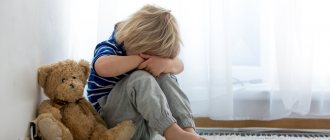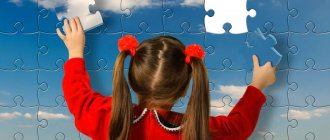Autism is a disorder of brain development characterized by severe and pervasive deficits in social interaction and communication, as well as restricted interests and repetitive behaviors. All these signs appear before the age of three years. Similar conditions with milder signs and symptoms are referred to as autism spectrum disorders.
The causes of autism are closely related to genes that influence the maturation of synaptic connections in the brain, but the genetics of the disease are complex, and at the moment it is not clear what influences the occurrence of autism spectrum disorders more: the interaction of many genes or rare mutations. In rare cases, a strong association of the disease with exposure to substances that cause birth defects is found. Other proposed causes are controversial—in particular, there has been no scientific evidence to support the hypothesis linking autism to childhood vaccinations. According to data from the United States, in 2011-2012, autism and autism spectrum disorders were officially diagnosed in 2% of schoolchildren, which is a significant increase compared to 1.2% in 2007. The number of people diagnosed with autism has risen sharply since the 1980s, partly due to changing approaches to diagnosis; It is unclear whether the actual prevalence of the disorder has increased.
In autism, changes have been noted in many areas of the brain, but exactly how they develop is unclear. Parents usually notice signs of the disorder during the first two years of a child's life. Although early behavioral and cognitive interventions can help a child gain self-help skills, social interactions, and communication, there is currently no known cure for autism.[3] Few children manage to move on to independent life upon reaching adulthood, but some achieve success[9]. Moreover, a unique culture of autistic people has emerged, a number of whose representatives are searching for a cure, while others believe that autism is more of a “special” alternative condition than a disease.
Classified as a disease of the nervous system, autism manifests itself primarily in developmental delays and reluctance to interact with others. This condition most often occurs in children under three years of age. Symptoms of this disease do not always manifest themselves physiologically, but observation of the child’s behavior and reactions makes it possible to recognize this disorder, which develops in approximately 1-6 children per thousand. The causes of autism have not been fully identified.
Characteristic
Autism is a disorder of the development of the nervous system, which is characterized by diverse manifestations, first noted in infancy or childhood, and a stable course of the disorder, usually without remissions. In infancy, it is worth paying attention to such symptoms as a distortion of the reaction to discomfort, excessively violent reactions of fear and crying in response to weak auditory stimuli and minor changes in the environment, but weak reactions to strong stimuli; There is also a weakening of the reaction to the feeding position, and the expression of pleasure after feeding is insignificant. In children, the reactions of the “revitalization complex”, characterized by an affective readiness to communicate with adults, are distorted. In this case, the components of the revitalization reaction appear in the absence of an adult and relate to inanimate objects, for example, to a toy hanging over the bed. Symptoms usually persist in adults, although often in a milder form. One symptom is not enough to define autism; the presence of a characteristic triad is required:
- lack of social interactions;
- impaired mutual communication;
- limited interests and a repetitive repertoire of behavior.
Other aspects, such as selectivity in food, are also common in autism, but are not significant in the diagnosis.
Autism is one of three autism spectrum disorders (ASD; see classification). Individual symptoms of the “triad” are found in the general population, and the degree of their association with each other is low and pathological manifestations are located in a single continuum with features common to most people.
Autism is a condition characterized by a predominance of a closed inner life, active withdrawal from the outside world, and poor expression of emotions.
The recipe is simple - give yourself completely
Christopher and Rhona Robertson, with whom we began the story, fearfully await the time when their son becomes a teenager. After all, he will face more and more new difficulties. They are very afraid that his condition will regress and are trying to do everything possible to prevent this.
“The problems are already here, and they need to be solved somehow, which is what we are doing,” says Christopher. “We know we have to teach Jamie the social skills he can’t live without.” There is no magic pill, and our formula cannot be said to work for everyone. My only fear is that other parents, having heard all the unpleasant things about autism that we heard, will give up and will not have the strength to fight. I believe that autism can be cured, you just have to give your whole self to the child.”
Social disorders
Impairments in social interactions distinguish autism spectrum disorders from other developmental disorders. A person with autism is incapable of full social communication and often cannot, like ordinary people, intuitively feel the state of another person. Temple Grandin, a prominent autistic woman, described the inability to engage in the social interactions of neurotypicals, or people with normal neurodevelopment, as feeling like “an anthropologist on Mars.”
Social impairments become noticeable in early childhood. Infants with autism pay less attention to social stimuli, smile and look at other people less often, and respond less often to their own name. During the period of learning to walk, the child deviates even more noticeably from social norms: he rarely makes eye contact, does not anticipate an attempt to pick him up by changing his posture, and more often expresses his desires by manipulating the hand of another person. At the age of three to five years, such children are less likely to demonstrate the ability to understand the social situation, are not inclined to spontaneously approach other people, respond to their expression of emotions or imitate other people's behavior, participate in non-verbal communication, and take turns with other people. At the same time, they become attached to those who directly care for them. Their confidence in attachment is moderately reduced, although with higher intellectual development or less severe autistic disorder this indicator is normalized. Older children with autism spectrum disorders perform worse on face and emotion recognition tasks.
Contrary to popular belief, autistic children do not prefer to be alone; they find it difficult to form and maintain friendships. According to research, their feelings of loneliness are associated more with the low quality of their existing relationships than with a small number of friends.
Although there are many anecdotal reports of violence and aggression among individuals with autism spectrum disorder, systematic research on this topic is limited. Limited evidence suggests that autism in children is associated with aggression, destruction of property, and temper tantrums. According to a 2007 survey of parents, two-thirds of 67 children with autism spectrum disorder had serious temper tantrums, and one in three showed aggression. According to the same study, anger attacks were more likely to occur in children who had problems with language acquisition. A 2008 Swedish study found that in a cohort of people over 15 years of age leaving a clinic with a diagnosis of autism spectrum disorder, violent crime was associated with comorbid psychopathological conditions such as psychosis.
Already in the first year of life, deviations such as the late onset of babbling, unusual gestures, a weak reaction to attempts at communication, and inconsistency when exchanging sounds with an adult can be observed. In the second and third years of life, autistic children babble less and less often, their speech has fewer consonant sounds, their vocabulary is lower, they combine words less often, and their gestures are less often accompanied by words. They are less likely to make requests and share their experiences, and are prone to echolalia (repetition of other people’s words) and reversal of pronouns (for example, in response to the question: “What is your name?” the child answers: “Your name is Dima,” without replacing the word “you” on me"). Acquisition of functional language appears to require “joint attention.” Poor development of this ability is thought to be a hallmark of infants with autism spectrum disorders: for example, when they try to point to an object, they look at the hands and rarely point to objects in order to share the experience with other people. Autistic children may be It is difficult to play games that require imagination and move from individual words to coherent language.
How to diagnose autism in a child
An accurate diagnosis can only be made clinically. To do this, you need to observe the child and note possible symptoms and signs. In addition, there are currently a sufficient number of tests that can help make a diagnosis.
When performing tasks to determine the level of development, very often children use nonverbal communication. And they cope with tests in which you need to show something and not say it with a bang. That is why you should choose several diagnostic methods.
If parents notice symptoms of autism, they should immediately contact a psychiatrist, otherwise the diagnosis may be delayed, which will significantly reduce the child’s chances of successful treatment.
Other symptoms
Generalized learning disabilities. Most people have it. For these children with the most severe forms of autism, there is a pattern: 50% have an IQ < 50, 70% < 70, and almost 100% have an IQ < 100. Although Asperger's syndrome and other autism spectrum disorders are increasingly being identified in children with normal intelligence (including above average), these milder autistic disorders are also often accompanied by generalized learning disabilities.
Seizures. Occurs in about a quarter of autistic individuals with generalized learning disabilities and about 5% of autistic individuals with normal IQ. Seizures often begin during adolescence.
Hyperactivity and lack of concentration. Often, obvious hyperactivity manifests itself during tasks imposed by adults (for example, schoolwork), while the child can concentrate well on independently chosen tasks (for example, lining up cubes in a row, watching the same cartoon over and over again). However, in other cases of autism, poor concentration is observed in all activities.
Severe and frequent outbursts of anger are common and may be caused by the child's inability to communicate his needs or by someone interfering with his rituals and routine.
Autistic people may experience symptoms that are not related to the diagnosis but have a significant impact on the patient or family. Between 0.5% and 10% of individuals with autism spectrum disorder exhibit unusual abilities, ranging from narrow, discrete skills such as memorizing trivial facts to the extremely rare talents found in savant syndrome.
It is known that children with developmental disorders are more likely to have sleep problems, and in the case of autism, some evidence suggests that these problems are even more common; Autistic children may have difficulty falling asleep and may wake up frequently in the middle of the night and early in the morning. According to a 2007 study, about two-thirds of autistic children will experience sleep problems in their lifetime.
Parents of autistic children suffer from increased levels of stress. Siblings of autistic people are less likely to come into conflict with them and are more often objects of admiration for them, but in adulthood they are more likely to experience poor health and deteriorated relationships with their autistic sibling.
We will enter his world ourselves
Many parents agree with June: over the years, their children’s autism only gets worse, and no improvements in their condition are observed.
Paul Stewart's son Andrew was diagnosed with autism when he was four years old. “While the child is small, his problems may not be noticeable. People often say: “It’s okay, it’ll grow up,” says Paul, a teacher from Glasgow. – Now Andrew is 16, and his problems are visible to the naked eye. After all, people expect more from him than from an 8-year-old child.”
Paul understands parents who don’t want to come to terms with their child’s diagnosis. “They send their children to regular schools in the hope that they will become “like everyone else,” but it never works. Of course, I would like to wave a magic wand and say: “there is no more autism” - but this is impossible.”
Paul and his wife decided not to waste time and money on methods that most likely would not help. They decided to enter Andrew's world themselves and try to make his life as easy as possible.
“Andrew is at his worst in the mornings,” says Paul. – He himself may wear the wrong trousers, forget money for school lunch or his coat, forget to brush his teeth, and so on. So we came up with a checklist for him to live by, and now nine times out of ten he does everything right. But this does not happen because he began to think differently. We simply create the appropriate conditions for it to act correctly. Autism is here to stay, and my son will never be able to do things automatically like, say, me.”
Andrew now goes to a magnet school, but takes football courses at a regular college. He has many friends in the youth group at his local church. His parents believe he will eventually be able to live independently.
“Andrew really wants to be independent, and I can’t be with him forever, so when the time comes, we will place him separately. He will have helpers, he will feel comfortable and gradually get used to life without us,” says Paul.
Causes
It has long been believed that the triad of symptoms characteristic of autism is caused by some common cause operating at the genetic, cognitive and neuronal levels. However, there is now growing evidence that autism is instead a complex disorder, with key aspects arising from separate causes, often acting simultaneously.
Deletions(1), duplications(2) and inversions(3) are chromosomal abnormalities that may be associated with the development of autism.
Much of the development of autism is genetic, but the genetics of autism are complex, and it is unclear whether the predominant influence on the development of autism spectrum disorder is the interaction of multiple genes or rare mutations that have a strong effect.[4] The complexity is due to the multifaceted interactions of a large number of genes, the environment and epigenetic factors that do not themselves change the DNA code, but can be inherited and modify gene expression.
In early twin studies, the heritability of autism was estimated to be more than 90%, provided the children lived in the same environment and were free of other genetic or medical syndromes. However, most mutations that increase the risk of autism remain unknown. As a rule, in the case of autism, it is not possible to trace the connection of the disorder with a Mendelian mutation (affecting a single gene) or with a single chromosomal aberration, as in Angelman or Martin-Bell syndrome. A number of genetic syndromes are associated with autism spectrum disorders, but none of them have symptoms that fit exactly into the typical pattern for such disorders. Many candidate genes have been discovered, but the effect of each is very small.
Gene replacement experiments in mice suggest that autism symptoms are closely associated with later developmental stages, in which synaptic activity and its associated changes play an important role, and that gene replacement or modulation of their activity after birth may alleviate or reverse symptoms. violations are reversed. All known teratogens (substances that cause birth defects) associated with autism risk are shown to have their effects within the first eight weeks after conception. Although these data do not rule out the possibility of later initiation or influence of the mechanisms of autism, they provide strong evidence that the basis of the disorder lies in the earliest stages of development.
There is only fragmentary evidence of other external factors that may cause autism, and these are not confirmed by reliable sources,[6] but active research is being conducted in this direction.[57] Possible contributions to the development of autism or the severity of the disorder have been suggested for many environmental factors, and some of the proposed interactions may prove useful as a focus of study. These factors include certain foods, infectious diseases, heavy metals, solvents, diesel exhaust, PCBs, phthalates and phenols used in plastics, pesticides, brominated flame retardants, alcohol, smoking, drugs and prenatal stress.
The timing of a child's routine vaccination may coincide with the time parents first notice autistic symptoms. Concerns about the role of vaccines have led to lower immunization rates in some countries, increasing the risk of measles outbreaks. However, the overwhelming majority of scientific studies have not found a connection between the MMR vaccine and autism, nor have there been convincing scientific evidence of the impact of thimerosal added to vaccines on the risk of developing autism.
Treatment methods for autism in children
An integral part on the path to curing a child from autism are procedures, physical exercises, and dietary adjustments. Such actions will teach the baby to control the body and perform some skills that are necessary for the development of independence. However, there are no standardized treatment methods, so everyone resorts to their own.
Something to remember! What helps one may not be effective for another. If the method recommended by someone does not show results, you must resort to the following.
Parents should choose a treatment method based on the child’s individuality, making sure to coordinate all their actions with the child’s attending physician. Before agreeing to any experiment, you cannot help but think about how the baby will perceive it. With the right choice of treatment, the likelihood of developmental success is high.
Children with autism are taught to manage their behavior. And the sooner you start doing this, the greater the opportunity to achieve good results.
Unfortunately, you should not hope that the treatment will be quick; you need to be patient and strong. And most importantly, the parents’ attitude, their attitude to what is happening and acceptance of the situation is already 50% of success.
Therapy and training
During special classes for preschoolers at the Neuropsychiatric Institute of the University of California: an autistic child points at aquarium fish. Researchers are trying to evaluate the effects of intensive training with a focus on joint attention on language development.
The main goals of therapy are to reduce autism-associated deficits and tension in the family, improve the quality of life and functional independence of the autistic person. There is no single optimal treatment method; it is usually selected individually. Methodological errors made when conducting studies of different therapeutic approaches do not allow us to speak with confidence about the success of a particular concept. Some improvements have been observed with many psychosocial interventions; this suggests that any help is better than no help. However, the methodology of systematic reviews remains poor, the clinical results of interventions are largely unclear, and there is a lack of data on the comparative effectiveness of approaches.
Intensive, long-term special education and behavioral therapy programs early in life can help a child develop self-help skills, communication skills, job skills, and often improve level of functioning and reduce the severity of symptoms and maladaptive behavior. Claims that support is particularly important around age three are not supported by evidence.[ Available approaches include applied behavior analysis, develompental models, structured learning (TEACCH), speech therapy, social skills training , occupational therapy. Within the framework of applied behavior analysis, several approaches have been identified specifically for children with autism and autism spectrum disorders: discrete trial training, pivotal response treatment, spontaneous learning and applied speech behavior ( English applied verbal behavior.To some extent, children benefit from such educational interventions: intensive use of applied behavior analysis has improved the overall level of functioning of preschool children, and has been well established as a method for increasing the intellectual performance of young children. Neuropsychological data is often poorly communicated to teachers, which creates a gap between recommendations and the nature of teaching.It is unknown whether programs for children lead to significant improvements after they grow up, and the scant research on the effectiveness of adult community-based programs suggests mixed results.
To control autistic symptoms when behavioral intervention is unsuccessful, when manifestations of the disorder do not allow the child to integrate into the school community or family, a wide range of medications are used. Thus, in the United States, more than half of children with autism spectrum disorders receive psychotropic or anticonvulsant medications, with antidepressants, stimulants, and antipsychotics most often prescribed. With the exception of the latter, the effectiveness and safety of the use of various drugs for autism spectrum disorders is extremely poorly reflected in high-quality scientific publications. In a person with the disorder, medications may cause atypical reactions or adverse side effects, and no known medications have been shown to alleviate key communication and social problems in autism.
Due to communication difficulties, autistic children are often unable to communicate the side effects of psychotropic medications, and the discomfort they experience as a result of these side effects may manifest as an increase in the very pathological behavior that is being treated. Studies have shown a high risk of developing extrapyramidal side effects of antipsychotics in autistic children, in particular tardive dyskinesia. Neuroleptics are not advisable to use in autism, with the exception of only the most severe cases of uncontrolled behavior - with a pronounced tendency to self-harm and aggressiveness, resistant to other interventions (in cases where behavioral therapy, correction of existing neurological and somatic disorders, mood stabilizers and antidepressants were ineffective).
Although a wide range of alternative approaches and techniques are available, few have been the subject of scientific research.] Outcome data from such approaches are rarely linked to quality of life measures, and many programs use measures that lack predictive validity and are far removed from reality. Organizations offering services to parents of autistic people, when choosing methods, seem to be guided primarily not by scientific data, but by the marketing offers of program authors, the availability of training for their employees, and the requests of parents. Although most alternative methods, such as using melatonin, cause only minor side effects, some may pose risks to the baby. Thus, a 2008 study showed that, compared with their peers, autistic boys on a casein-free diet had thinner bones. In 2005, inadequately administered chelation killed a five-year-old autistic child.
Treatment costs for autism are high; indirect losses are even higher. According to a US study, the average lifetime cost for a person with autism born in 2000 would be $3.2 million in 2003 purchasing power, with about 10% spent on medical care and 30% on additional education and care, and losses in economic productivity will account for the remaining 60%. Programs funded by grants and donations often do not address the needs of the individual child, and parents' unreimbursed out-of-pocket costs for medications and other therapies can leave families in financial distress. A 2008 US study found that the average annual income loss of a family with an autistic child was 14%, and another related publication found that the challenge of caring for a child with autistic disorder can have a significant impact on a parent's work life. . Once adulthood is reached, issues of community care, vocational and job search, sexual relationships, the use of social skills, and estate planning come to the fore.
Forecast
Autism cannot be cured using known methods. At the same time, sometimes remission occurs in childhood, leading to the removal of the diagnosis of autism spectrum disorder; Sometimes this happens after intensive care, but not always. The exact recovery rate is unknown; in unselected samples of children with autism spectrum disorders, rates range from 3% to 25%. Most children with autism lack social support, stable relationships with other people, career prospects, and a sense of self-determination. Although underlying problems remain, symptoms often subside with age.
The number of high-quality studies on long-term prognosis is small. Some autistic adults show modest improvements in communication skills, but a fair number experience decline in these skills; There is not a single study analyzing the condition of autistic people past middle age.
Development of language skills before the age of six, an IQ level above 50 units and the presence of a sought-after profession or skill are signs that predict better performance in the future; a person with severe autism has a low chance of achieving independence.[136] According to a 2004 British study, in a cohort of 68 autistic people diagnosed as children before 1980 with an IQ above 50, only 12% achieved a high level of independence in adulthood, 10% had few friends and were busy most of the time, but required some support, 19% had some independence but tended to stay at home and needed a lot of support and day-to-day supervision, 46% required the care of an autism specialist, increased support and had only some autonomy, and 12% required highly organized hospital care. According to Swedish data from 2005, in a group of 78 autistic adults selected without cut-off based on IQ level, the results were worse: for example, only 4% lived an independent life. A Canadian publication based on the results of an analysis of 48 young people with autism spectrum disorders diagnosed in preschool age identified subgroups with poor (46%), moderate (32%), good (17%) and very good (4%) levels of functioning; 56% of them had a job at least once in their life, mostly volunteer, adapted or part-time.
Changes in diagnostic practice, as well as the increased availability of effective early intervention methods, call into question the applicability of the above data to children currently being diagnosed.
Panacea or dummy?
| Parents believe that their son is making progress thanks to intensive training in behavioral therapy, a popular method today. |
But not everyone believes that autism is such a simple matter. Richard Mills, an expert at Research Autism, says many parents find psychological treatments such as PAP helpful and effective, but warns that in the stress of receiving a diagnosis, it can be easy to be swayed by talk of a "miracle cure."
“The placebo effect is very powerful,” he adds. – If you see that everything is going well, continue. But be honest with yourself, and if you feel like something is wrong, stop. There are a lot of extravagant, and often simply useless, methods of treatment, which have zero benefit, but they cost a lot.”
The National Autism Research Society also urges parents to be careful. “There are many treatments,” says his representative, “the effectiveness of which we still do not know anything about. Only a few methods can boast of independent scientific evaluation.”
Here is the case of June Cox-Smith. Her son Edward (now 15) underwent PAP for four years, from three to seven. His mum June, 58, who lives in Ixham, Sussex, with her husband Patrick and their two children, says: “It cost £15,000 a year. I had to sell all my jewelry. PAP became a continuous, hard job. We sat and made dozens of attempts to make at least one sound, rested a little - and everything started all over again. The first attempts were a nightmare, but after a year Edward's behavior became much better. Over the next two and a half years we taught him to speak. This is truly an amazing achievement!”
Over the next year, Edward learned to read. At the age of six, he went to a regular school, where June was his PA assistant. But something went wrong. “Edward got worse at school,” says his mother. “He didn’t understand what was happening.” He was used to working alone, rather than sitting quietly with a group of other children and listening to a lesson. If I wasn't around, he got scared and tried to run away.
Eight months later, the parents were forced to transfer their son to a specialized school. Although June admits Edward learned to speak and read thanks to PAP, she now believes she was overly optimistic about her son's recovery: “We spent thousands of hours trying to teach him subjects like maths, geography and history - all to no avail. They tried to teach him games. But autistic people don't play. A whole propaganda campaign was launched with stories about children being healed - and I so wanted it all to be true. You want to help your child so much that you forget for a while about your own mistrust and skepticism.”
Christopher Robertson believes that children like his son need to be introduced to the world around them and given the chance to be independent.
Now June is firmly convinced that children with autism can only learn to live with their condition, but there will never be any improvement in it: “Nothing can change their view of the world. Their brain is damaged and there is nothing you can do about it. If you think your child is cured, it means they didn't have autism at all, she says. - And further. I came to the conclusion that trying to “treat” them is generally wrong. My son is like a soft, sweet little bear. He just happens to be a little different.”
Epidemiology
Number of autism diagnoses given to children aged 6-17 years in the United States per 1,000 people. Reporting of autism cases increased significantly in the United States from 1996 to 2007. It is unknown to what extent this jump may be due to increased prevalence.
Most recent reviews agree that the incidence rate is 1–2 people per 1000 for autism and about 6 people per 1000 for autism spectrum disorder, although insufficient data in the latter case may mean the actual number is higher. Unspecified profound developmental disorder affects 3.7 people out of 1000, Asperger's syndrome - approximately 0.6, childhood disintegrative disorder - 0.02 per 1000. In the 1990s and early 2000s, the number of reports of new cases of autism increased significantly . In 2011-2012, every 50th schoolchild in the United States and every 38th schoolchild in South Korea had autism spectrum disorders [source not specified 899 days]. This increase is largely due to changes in diagnostic procedures, referral rules, availability of appropriate services, age of diagnosis and the level of public awareness of the problem of autism, although the emergence of some additional environmental factors cannot be ruled out. Available evidence does not rule out an increase in the actual prevalence of the disorder; in this case, more attention should be paid to changing external factors, without focusing on genetic mechanisms.
Autism spectrum disorders are more common in boys than girls. The number of new cases is 4.3:1 in favor of males, and it fluctuates significantly when taking into account cognitive indicators: for example, according to rough data from one study, autism in combination with mental retardation occurs only twice as often in boys (2:1) , and without mental retardation - five and a half times more often (5.5:1) than in girls. The development of autism is also associated with several pre- and perinatal risk factors. A 2007 review identified factors such as increased maternal or paternal age, place of birth outside Europe and North America, low birth weight, short pregnancy, and hypoxia during childbirth. Most professionals agree that race, ethnicity and socioeconomic background do not influence the development of autism.
The importance of differential diagnosis
When identifying autism, it is important to distinguish it from other disorders, such as hearing or vision problems, developmental delays, or speech impairment. There are certain diseases that can resemble autism, so they need to be ruled out by having your baby tested. This may include:
- blood and urine test
- ENT tests – to rule out speech problems
- test for toxoplasmosis and cytomegalovirus
- hearing test – to rule out hearing problems,
- neurological tests – performed to rule out other neurological disorders
- ophthalmological examinations - to exclude vision problems,
- genetic or metabolic testing – often performed by parents to rule out a hereditary factor.










